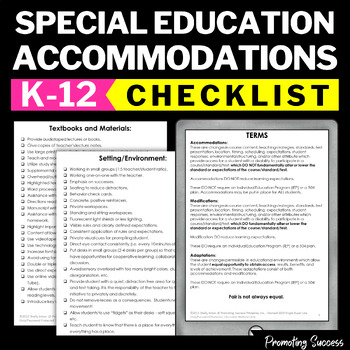Fair isn’t always equal—and that’s okay.
In every school classroom, you’ll find students with different needs, learning styles, and strengths. That’s why providing math accommodations isn’t just acceptable—it’s necessary for many learners to succeed. Whether it’s part of an IEP, 504 plan, or just a thoughtful response to a student’s struggles, accommodations allow all students to access the same content in ways that work for them.
Let’s clear something up:
- A modification changes the learning goal or expectation.
- An accommodation provides support so a student can reach the same goal as their peers.
And here’s the best part: accommodations are not just for students in special education. Any student, at any grade level, may need help at different times. That’s why using formative assessments is essential to know when and where support is needed.
💬 If a child can't learn the way we teach, we must teach the way they learn.
Below are five reasonable and effective math accommodations you can use right away.
1. Use Math Fact Charts
When students are solving higher-level problems, the focus should be on thinking, not memorization. If a student struggles with recalling basic math facts, a simple fact chart can remove that barrier and let their problem-solving skills shine.
🎯 Math fact charts help students succeed with:
- Multi-step word problems
- Multi-digit operations
- Advanced math concepts
Tip: Use fact charts as a scaffold, not a crutch. They’re a tool to help students move forward, not a replacement for practice.
2. Provide Graph Paper
Messy math work often leads to errors—not because students don’t understand, but because their numbers aren’t lined up correctly. Graph paper can be a game changer for visual clarity.
📌 Graph paper supports:
- Lining up operations
- Arrays and area models
- Fractions, decimals, data
- Geometry and skip counting
- Even/odd numbers, factors & multiples
Bonus: Some students even prefer graph paper for taking notes across all subjects!
👉 Download free printable graph paper and a long division strategy here.
3. Incorporate Number Lines
Number lines are one of the most underused math tools in the classroom. They give students a powerful visual for understanding operations, fractions, and number relationships.
✅ Use number lines for:
- Addition, subtraction, multiplication, division
- Fractions as parts of a whole
- Building number sense
The number line helps students see math as a journey—not just a right or wrong answer.
👉 Get a free fractions on a number line worksheet.
4. Create and Use Math Anchor Charts
Anchor charts make thinking visible. They’re perfect for showing strategies, steps, or key concepts—especially when students need visual reminders.
🧠 Use math anchor charts for:
- Place value and number sense
- Comparing numbers
- Operation strategies
- Fractions, geometry, and more
Pro tip: Use anchor charts during mini-lessons and keep them posted as long as needed. Eventually, you can phase them out as students gain independence.
👉 Check out this free comparing numbers anchor chart.
5. Chunk the Work
Long worksheets or tests can overwhelm students—especially those with attention, anxiety, or executive functioning challenges. Chunking breaks work into smaller, manageable parts.
🛠️ Try these chunking strategies:
- Cut worksheets into sections
- Use “To Do” and “Completed” bags
- Cover parts of a page with paper
- Assign only selected problems (e.g., odds)
- Use paper “windows” to isolate questions
Remember: We’re assessing understanding, not endurance.
Task cards are another fantastic alternative. Instead of 50 problems, give students 5 cards to show mastery. If they get them right—move on!
👉 Explore 50+ FREE task card sets here.
Final Thoughts
Providing math accommodations isn’t lowering the bar—it’s giving students the tools they need to reach it. Whether it’s a formal IEP, a 504 plan, or just good teaching, these reasonable supports make a difference. Every student deserves access to meaningful learning—and that means meeting them where they are.
Remember: It’s okay (and smart) to provide math accommodations.
--------------------------------

.png)





Good ideas!
ReplyDeleteAccommodation is more of an attitude than an act - an attitude focused on easing the situation for another human being, and it stems from empathy. If one lacks empathy, you can never expect an accommodating behavior from him because empathy is a prerequisite. And it’s not that difficult to spot empathy. The way someone communicates tells you if they will accommodate you or not. Never should you deal with a person who lacks empathy. If you are looking for the Best Bank For Student Loans In Uk 2021, notice how the representative talks before pulling the trigger and finalizing a deal. If you are at a doctor's clinic, notice how he treats you. If they have empathy, you can expect them to accommodate you in case things go south.
ReplyDeleteFor a university pupil, on the internet technique examinations are perfectly readily available online. There are kinds of parcc practice test math like the CLEP examination which assists a college trainee to acquire even more credit histories in his subject training courses.
ReplyDelete